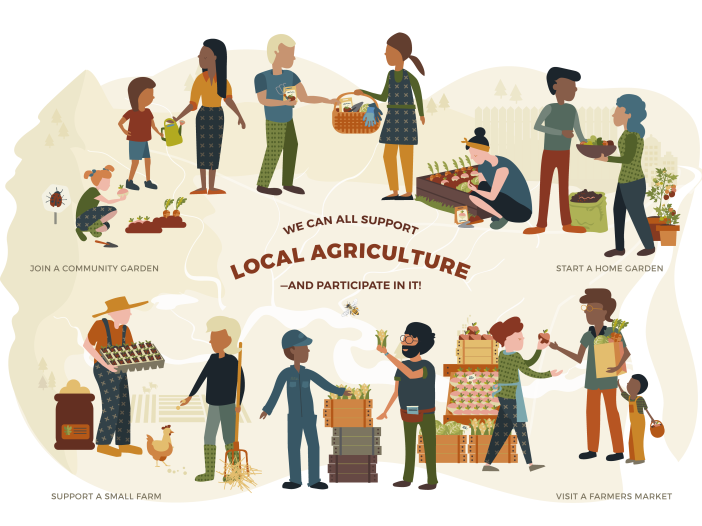Protecting Agricultural Viability in Washington County

By Kristina Peterson, Education & Outreach Specialist, Tualatin Soil & Water Conservation District

As Oregonians, we are lucky to have agriculture deeply seeded in our economy and cultural heritage. The Willamette Valley is one of the most diverse agricultural regions on earth due to its rich, fertile soils and ample rainfall. Washington County is among the top-producing agricultural counties in the state and home to thousands of acres of farms, farming families, and farm-related businesses. About 25% of the county is agricultural land. However, we are losing this land to development at rapid rates. As Washington County’s population continues to grow, it’s important to protect productive agricultural lands and ensure that farming communities continue to thrive.
What is Agricultural Viability?
The term “agricultural viability” refers to all the components of the agriculture system that need to stay in motion to sustain a thriving local agriculture community. This can be thought of as the overall health of the land along with the support of agriculture in the larger landscape and community. A thriving agricultural community depends on availability of productive farmland with adequate water supply and healthy soil; enough skilled farmers and field workers to plant and harvest crops, tend to livestock, and maintain the land; access to farming equipment, material suppliers, and markets for farmers to sell their food and goods, and engaged community members to support their local agriculture community.
Maintaining agricultural viability requires understanding the importance of agriculture in our health, economy, livelihood, and environment. Without this shared vision, our agriculture community is threatened.

What Threatens Agricultural Viability?
As Washington County continues to grow, the local agricultural community is compromised. This changing landscape leads to:
Decreased availability of highly productive farmland—Without conservation easements or succession plans, farmland is vulnerable to development. Once developed, it will likely never return to farming or open space. Productive soils are one of the most important land characteristics to support agriculture. Washington County has some of the most productive soils in the state.
Fragmented agricultural land and farming communities—Fragmentation divides the land in ways that will make farms too small to be profitable and farmland that is unaffordable for farmers. Farmers also rely on each other for sharing equipment, knowledge, and the collective benefits of conservation practices. When farming lands are divided, farmers lose an important support system.
Limited farming resources – Field workers and farmers utilize specific equipment, infrastructure, materials, and production spaces. Local businesses and infrastructure who hold these resources don’t have financial support for upkeep and maintenance. They are also seeing decreased demand and are moving to locations where they can make larger profits.
Read more about threats to farmland here.
You can help support local agriculture!
Whether you live in a rural or urban area, you can help sustain our local agriculture community. Here are some ways that you can help:
Find a local farmer’s market: Purchase products directly from farms while getting to know your local farmers. Find your nearest farmers market through Oregon Farmers Markets Association.
Support local farms: You can visit a farm stand or farm store, participate in u-pick berry season, or sign up for a Community Supported Agriculture (CSA) program.
Discover what is grown in Washington County: Check out our Grown in Washington County map to learn about the variety of crops produced by local farmers.
Pay attention in agricultural areas: Look out for signs that indicate agricultural areas and what is being grown. Practice road safety on rural roads when farm equipment is present.
Agriculture is interwoven throughout our everyday lives whether we realize it or not. It is in the grocery stores we visit, the clothes we wear, the smiling farmers at farmers markets, and the nurseries where we buy our plants. Protecting agriculture today ensures local food, goods, farmers, and natural spaces for all in the future.
Learn more about how Tualatin SWCD promotes agricultural viability here.





